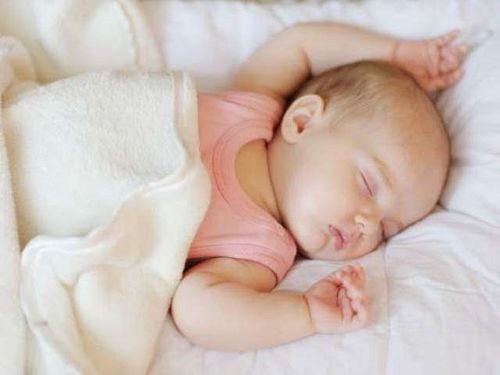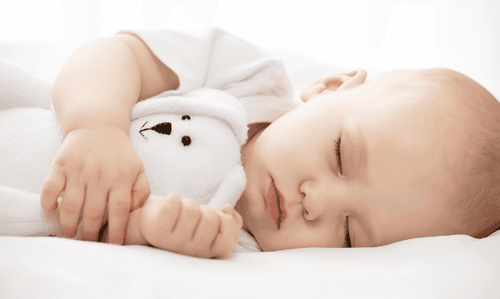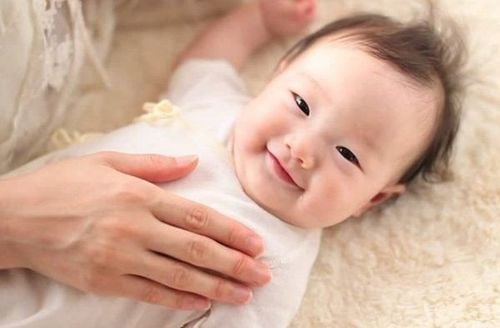This is an automatically translated article.
Infant sleep trackers used to be a popular item for young children. Safe sleep guidelines instruct new parents to put babies to sleep on their backs, so a product is designed to keep babies in this safe position and it's a good idea. .Sleep positioners can come in several different forms: Wedges or foam tubes that attach to the pad on which the baby sleeps, padded plastic tubes with mesh on the sides, or wedge-shaped pads with side pads. . All are designed to form a barrier on both sides to prevent the baby from rolling.
1. Is it safe to use a sleep locator for children?
Unfortunately, the answer to the question “Is it safe to use a baby sleep tracker?” again "No". In 2010, the US Food and Drug Administration (FDA) and the Consumer Product Safety Commission (CPSC) issued warnings to parents that they should stop using sleep trackers. sleep for children. The two agencies cite reports of 12 infants who died from asphyxiation when a sleep device was used, either in or out of the baby's crib.In addition, there are also dozens of other reports of infants being placed to sleep on their backs or sides in a sleep positioner, only to later find the infant lying on their stomach or next to the tracker. Sleep positioner problems have been going on for the past 13 years and are mainly related to two types of positioners: Flat mats with side pads and inclined mats with side pads. Unfortunately, these locators are still sold in the market and many parents have bought them to use for their children.
FDA regulates that children's products are considered medical devices if the manufacturer of these devices claims their product can cure, alleviate, treat, or prevent or reduce disease or medical condition in labeling, packaging or advertising. Some navigation devices are considered medical devices because of their intended use. This intended use has been shown on product labels, user manuals as well as product brochures. Sleep trackers do not meet the definition of a medical device set forth by the Consumer Product Safety Commission. Some types of baby sleep positioners may have pillows or bolsters attached to each side of the mat or a mattress to elevate the baby's head. Sleep positioners are usually soft-structured, hold babies in a specific position during sleep, and are often used on babies under 6 months of age.
No navigation device is considered secure. Sleep positioning devices are believed to have the effect of immobilizing babies in the supine position, one of the best lying positions to reduce the risk of sudden infant death syndrome as well as airway asphyxia in children, but They create dangers that parents and caregivers cannot anticipate.
The safest environment for a baby to sleep soundly and safely is a firm, flat mattress, nothing more than a bed sheet that fits your baby. Do not put anything else on the bed: No stuffed animals, blankets, pillows, night or any other positioning device either in or out of the baby's crib.

Môi trường an toàn nhất cho trẻ ngủ ngon giấc và an toàn là một tấm đệm phẳng, chắc chắn, không có gì khác ngoài một tấm trải giường vừa vặn với bé
2. How can babies sleep safely?
To ensure sleep as well as the safety of children when sleeping, parents need to note some of the following tips:Never use a sleep locator for babies. Using these products to immobilize a child on his or her side or back can be very dangerous. Never place pillows, blankets, sheets, comforters or blankets under a baby's bed or in a crib. These objects can also be dangerous for children. Newborns don't need pillows and suitable clothes can keep them warm in lieu of blankets. Always keep the area around where your baby sleeps clear. That means parents should never put objects or toys in a child's sleeping space. Always let your baby sleep on his or her back, even if it's just for a nap.

Cha mẹ không nên sử dụng thiết bị định vị giấc ngủ cho trẻ sơ sinh
3. An overview of infant asphyxiation and other hazards
According to the National Institute of Child Health and Human Development Eunice Kennedy Shriver (NICHD), every year about 4,000 infants die from asphyxiation, sudden infant death syndrome or unknown cause.The US government has received reports of infant deaths from asphyxiation related to navigation devices used by parents for babies. In most of these cases, the child suffocated when the sleep trackers blocked the airway. In addition to reports of deaths, the government has received reports of babies being placed on their backs or sides in a positioner but later found lying in other dangerous positions inside or next to these devices. To avoid the risk of sleep locators, experts recommend that the safest place for babies to sleep is the bare crib and the baby needs to be placed in the supine position while sleeping.
Some sleep device manufacturers have advertised their products as being able to prevent sudden sleep death syndrome (SIDS), gastroesophageal reflux disease (GERD), or flat head syndrome ( plagiocephaly) – a type of gravity-induced deformation of part of the skull.
However, the truth is:
The FDA has never confirmed that an infant sleep locator prevents the risk of sudden infant death syndrome. The FDA has also rejected the manufacturer's arguments that infant sleep trackers have the ability to prevent gastroesophageal reflux disease or even flat head syndrome. In 2010, the FDA became aware of infant sleep locators marketed with claims related to sudden infant death syndrome and notified manufacturers to discontinue marketing. these devices and submit information to assist FDA in clearance. The FDA also intends to take action against manufacturers of baby sleep devices that make unproven medical claims for their products. Parents can also keep their babies safe by not using sleep trackers.
Parents or caregivers can also report problems or problems with infant sleep trackers to the FDA's MedWatch program. In addition, they can also find more information regarding these types of devices on the official FDA website.
Finally, if parents have questions about how to ensure the safety of their baby's sleep or how to avoid and treat certain health problems for their baby, contact the doctor or specialist to consulted in the best possible way.

FDA chưa bao giờ xác nhận một thiết bị định vị giấc ngủ cho trẻ sơ sinh có khả năng phòng ngừa nguy cơ mắc hội chứng đột tử khi ngủ ở trẻ
Newborns in general are prone to respiratory diseases, respiratory infections and gastrointestinal infections if they are introduced to solid foods early or the storage and preparation of milk is not guaranteed. To protect children's health, parents should do well to exclusively breastfeed their babies for the first 6 months (if possible) and vaccinate on schedule.

Để bảo vệ sức khỏe của trẻ, cha mẹ nên thực hiện tốt việc cho bé bú mẹ hoàn toàn trong 6 tháng đầu (nếu được) và tiêm vắc-xin đúng lịch
Parents can learn more:
Signs of zinc deficiency in children
Micronutrient deficiency and failure to gain weight in children
Please regularly visit Vinmec.com website and update useful information to take care of your child. Take care of the baby and the whole family.
Reference sources: babycenter.com, fda.gov













